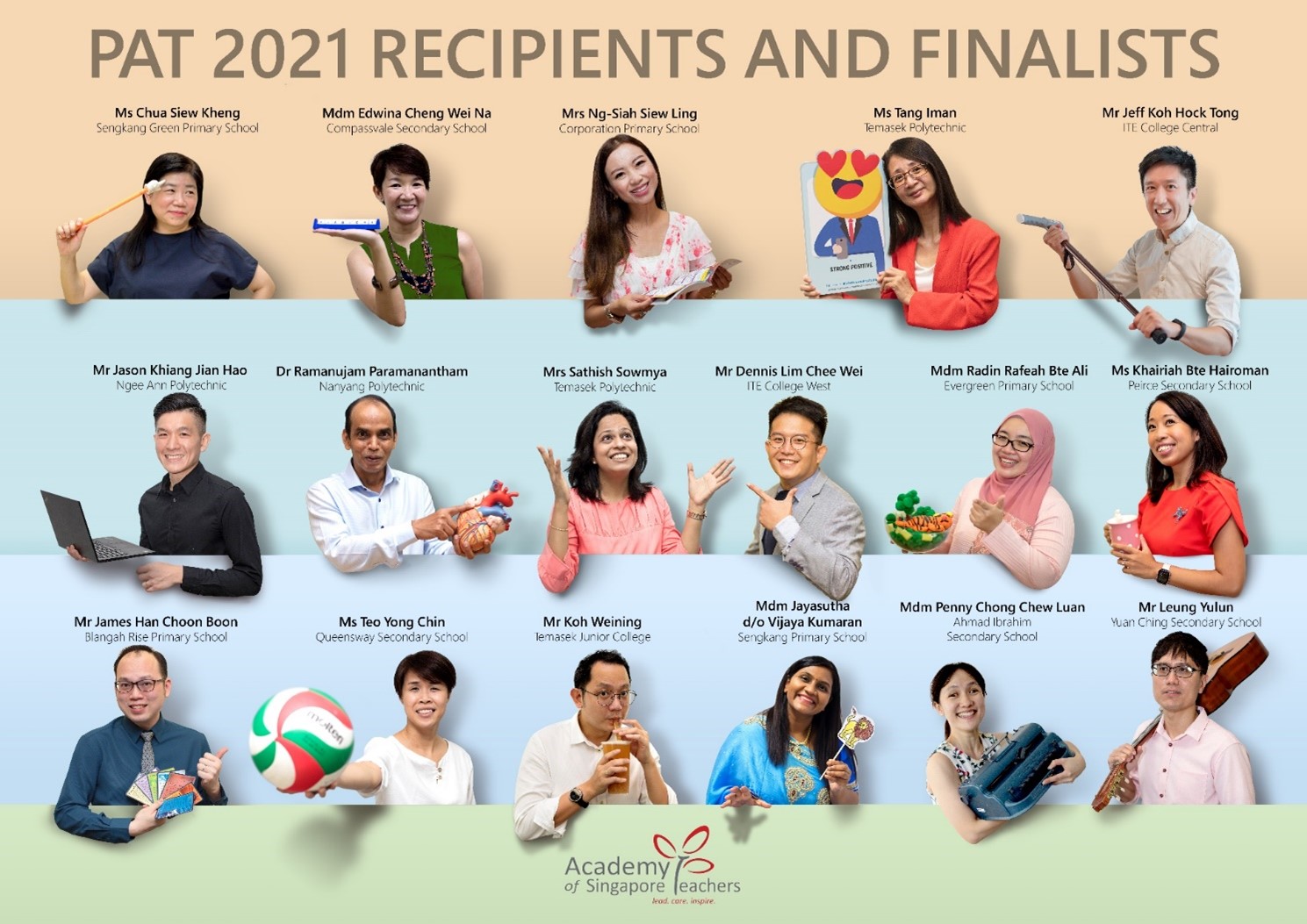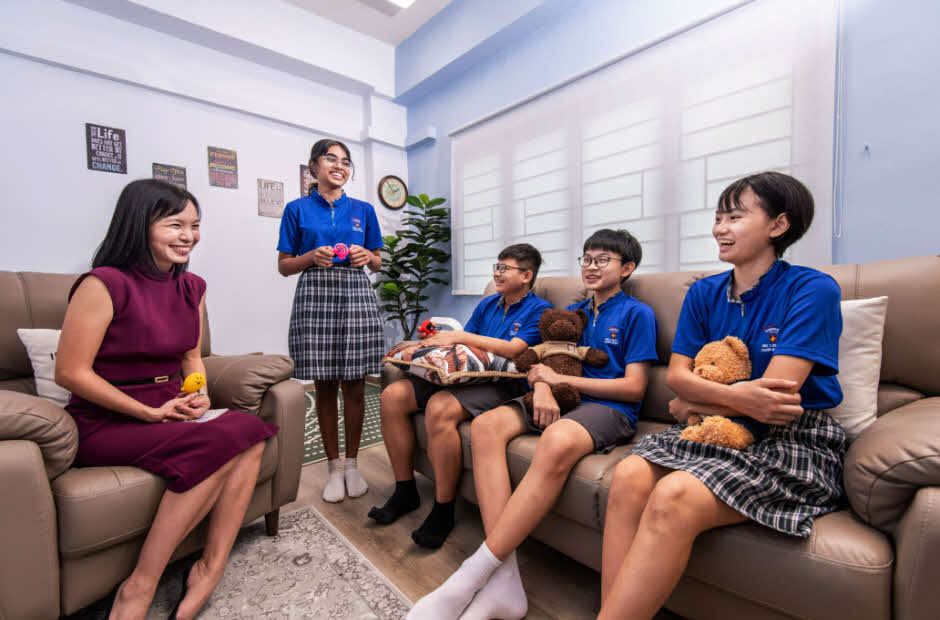Chua Siew Kheng, Sengkang Green Primary, President’s Award for Teachers 2021 Recipient
It was a chance recommendation from a friend’s mother to do a stint of relief teaching that launched Miss Chua Siew Kheng on her path as an educator. Since then, she has gone on to carve her niche in teaching English and PE at a primary school for more than 30 years. Her secret to longevity in the profession is simple; she just enjoys working with children.
However, the road to success has not always been smooth as she recalls an exchange at a bus-stop with an ex-student who remarked that she had always stood out as a firm disciplinarian in his memory. This set her reflecting on the legacy she wanted to leave as a teacher and how going forward she would need to rethink her interactions with her students.
“As much as what you teach them and how you teach them are important, a good relationship matters a lot between a teacher and a student. “
Hence in her substantial span of time as an educator, she has learnt to constantly reinvent her methods to kindle the flames of curiosity and passion in her students through positive classroom culture.
Making the classroom a safe space
Siew Kheng sets out to build positive relationships with her young charges, starting with a safe and welcoming learning environment where students are eager to speak up. She tells her students that they should treat their classroom as a second home, since they spend a big part of their time there with their teachers and classmates.
“If this is your home and you care for it, you will want to do your best,” she added.
To instill a sense of ownership in her students, she lays down a few ground rules: They have to be responsible for the upkeep of their classroom, and they have to treat each other with respect.
“Respect is very important. It makes children feel safe. I let them know that everybody’s views are important and respectful listening is expected, so we all have practise active listening.”
Siew Kheng’s students know that they can freely share their views and opinions with little fear of judgement from their fellow classmates. It makes her class a close-knit one where the atmosphere is lively and interactive.
To make the physical classroom a more conducive place for learning, Siew Kheng is working on designing a prototype classroom that promotes collaboration in the lower primary students. In the past, the classroom setup was fixed such that the teacher always stood in front facing rows of students. “Today, we want our students to come together to share, collaborate, and create,” she explained. Thus, furniture is made more portable to be easily rearranged and desks are arranged in different configurations – singly, in pairs or threes and in groups – to adapt easily to any learning activity.
“My Primary One students would stand around and write their ideas on big, standing whiteboards when working on group activities, and there are open spaces that allow students to sit or lie on the floor to write on big lined-paper.” All these to aid learning.
Making a conscious decision to like every student
With 31 years of primary school teaching experience under her belt, Siew Kheng has distilled two simple axioms that she applies with her students.
The first is making a conscious decision to like every student. In fact, at the start of every school year, she declares to each new class, “As long as you are in my class and you’re one of my students, I will make sure that I like you.”
She admits that this is not always easy as some students have challenging behaviour.
“Even if there are 10 things you don’t like, there will be at least one thing you like about a child. Build on that one thing you like first,” she said.
She finds that such positive affirmation makes a huge difference to the students’ behaviour. The children listen better, are less antagonistic, and share their thoughts more freely in class.
The second axiom she believes in is that every child wants to learn. She cited a recent incident where she was helping a trainee teacher manage her Primary 3 class, and had to pull aside a challenging student who had been rude and disruptive in class.
The student had told her defiantly that he did not want to be a good boy. When she told him that she didn’t believe him, he was taken aback. When she asked if he meant that he did not know how to be good, he admitted it.
She acknowledged that it can be hard work trying to meet a teacher’s expectations and assured him that his teachers would be there to guide him so that he would know what to do and not get into trouble again.
By consistently using this approach, Siew Kheng recasts the role of teachers in the eyes of her students. Instead of being strict disciplinarians, students see their teachers as mentors who are there to guide them in their learning journey.
More autonomy, more fun
As the English Language Head of Department in her school, Siew Kheng takes a similar child-centred approach to teaching.
She worked with the Principal to develop the “Language Learning is Progressive” teaching strategy to refresh and raise the standards for teaching and learning of English in the school. Via this game-changing move, certain skills were identified as more critical for success and hence given more focus, especially during the transition years of Primary 2 to 3, and Primary 4 to 5. Proper scaffolding was done to enable effective learning of concepts and skills.
Siew Kheng also coaches teachers to adopt a more nurturing approach by equipping them with skillsets to develop students of different strengths, interests and needs.
A common theme in their teaching strategies is giving students greater autonomy and choice in their classwork.
Differentiated Instruction in reading assessments is one such strategy. To cultivate confidence and the joy of reading, she worked with her colleagues to give students a choice of texts at varying levels of difficulty.
Lower Primary students get to pick some reading and writing activities according to their interests and proficiency. Some opt for draw-and-write exercises while others prefer composing short poems.
“The children find it more fun. Because of that, the teachers and I have found that they are then keener to write.”
Observing how students struggle to answer comprehension questions, Siew Kheng and her colleagues introduced annotation strategies to help them decipher the text: By identifying important elements in the text and relating it to information they have read, heard or experienced, students “think aloud” to improve their understanding.
At a higher level, students learn to ask questions or form opinions about the text.
“Students become more critical readers. The beauty of this method is that it applies to everything they read,” she pointed out.
‘Teachers, explain why you are being strict’
Over the years, when Siew Kheng hears about the unhappy memories that some people have of school, she reflects on the influence that teachers have beyond the classroom.
When teachers are strict – they may punish the whole class for the misdemeanour of a few, or insist that their students do things only a certain way – they have good intentions but often fail to share them, she says. Others believe that time is the best teacher and students will grow up and in reminiscing, realise that their teachers meant well.
But Siew Kheng challenges teachers not to take chances but instead, to seize the moment to build a stronger relationship with their students, and show that deep down, ”I care for you as a teacher, that’s why sometimes I’m a bit stricter with you. I believe that the children can understand that.”







